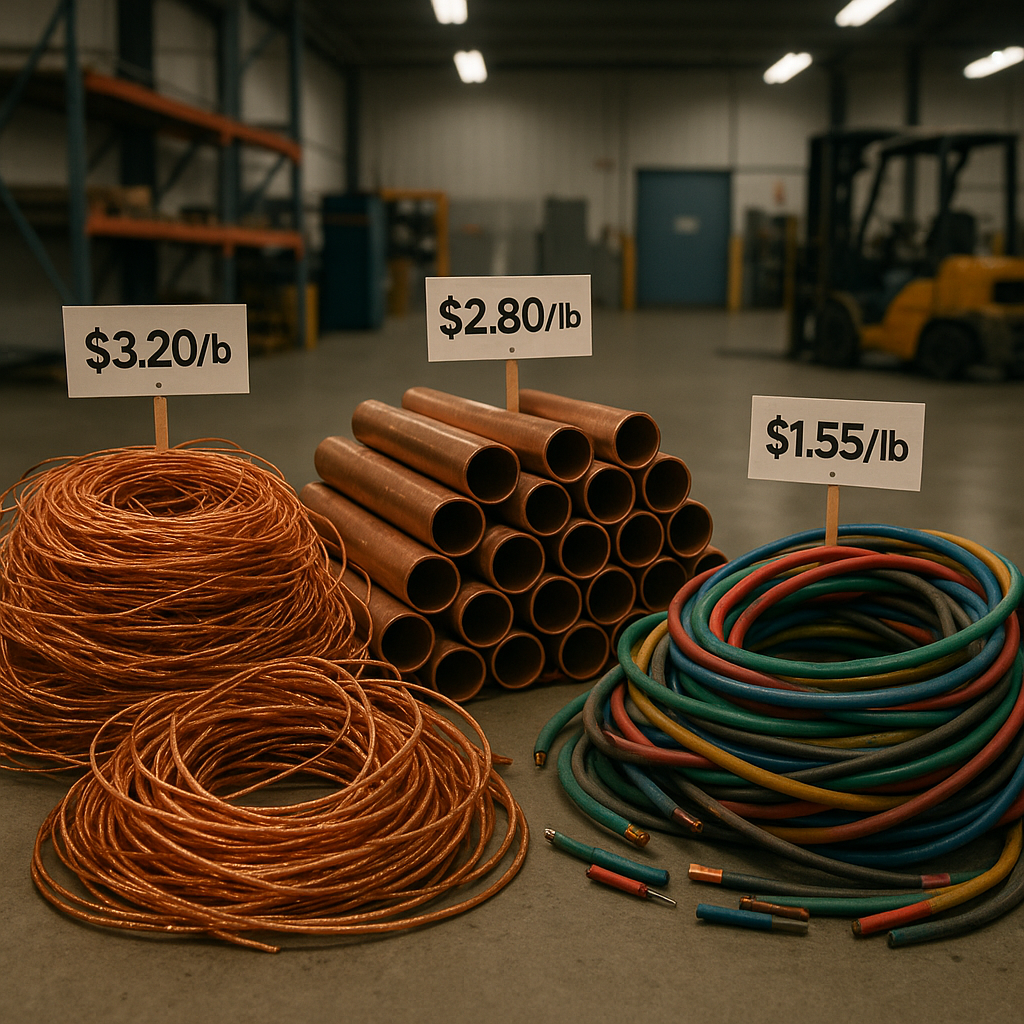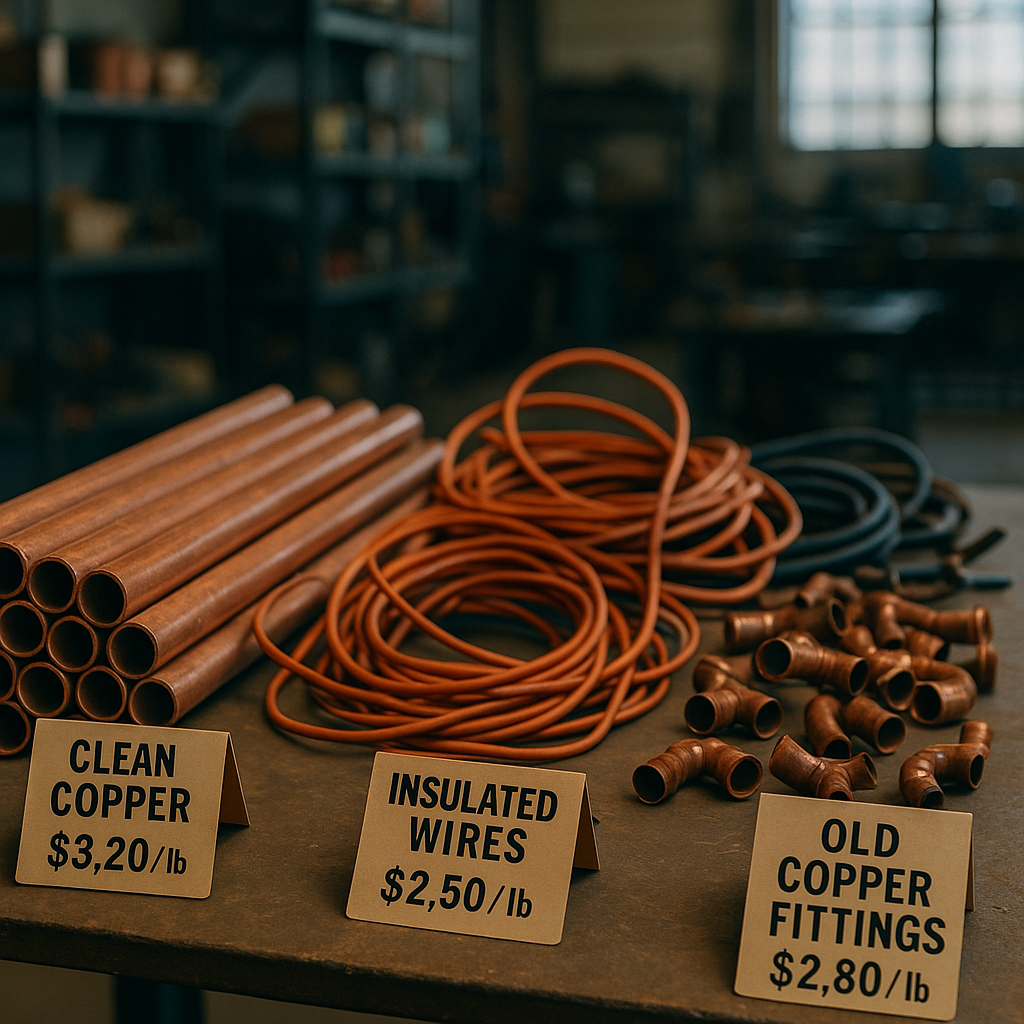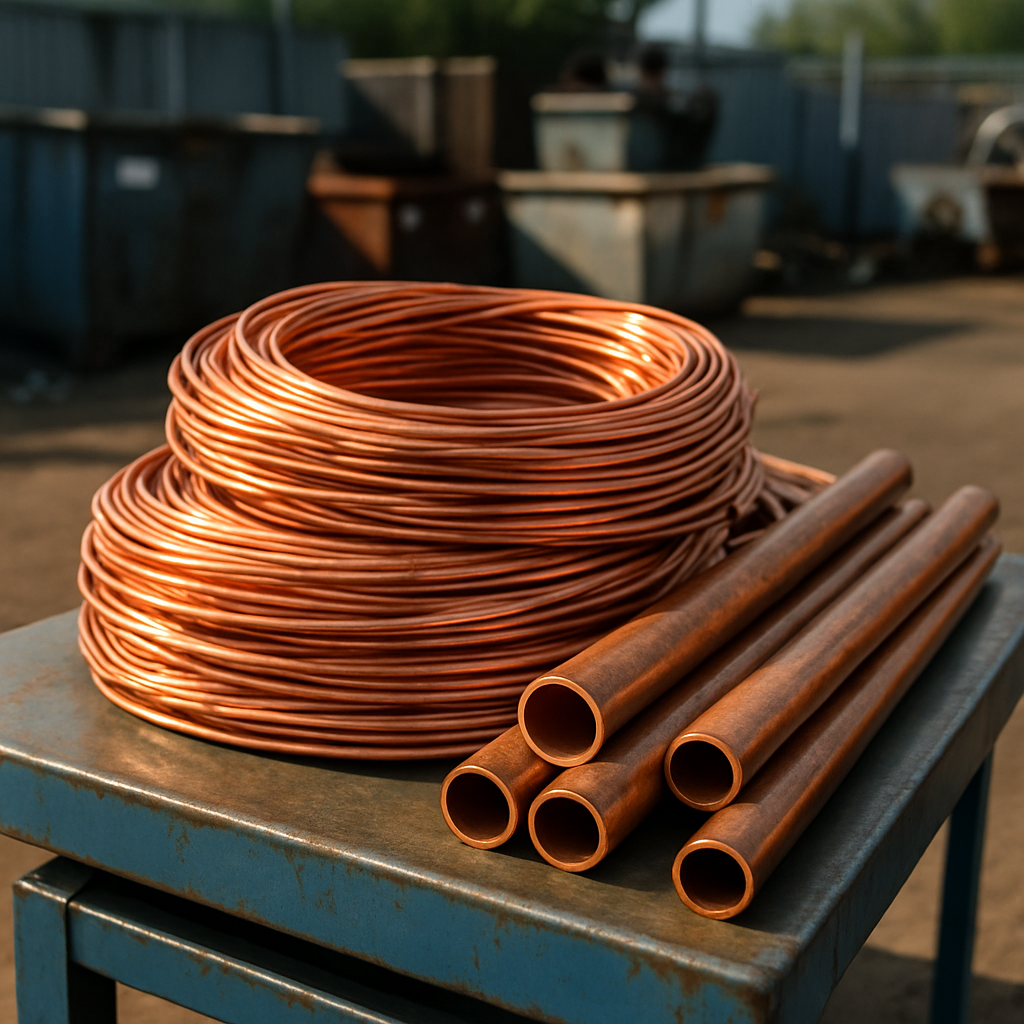5901 Botham Jean Blvd, Dallas, TX 75215
What Are Current Copper Salvage Prices?
June 27, 2025Copper remains one of the most valuable metals in the recycling market today. Bare bright copper wire leads the pack, commanding premium rates of $3.54-$3.65 per pound in current markets. This high-purity copper type is prized for its exceptional conductivity and minimal processing requirements.
#1 copper tubing follows closely, with salvage yards paying between $3.43-$3.63 per pound for clean, uncontaminated materials. The slight price variation reflects regional market differences and fluctuating demand in construction and manufacturing sectors.
Other copper varieties offer varying returns based on purity and condition. Standard #2 copper fetches about $3.35 per pound, while insulated copper wire brings in $1.15-$2.65 per pound, depending on insulation type and copper content. Specialty items like copper yokes may command approximately $0.44 per pound due to their mixed metal composition.
How Do Different Types of Copper Scrap Compare in Value?

The value of copper scrap varies significantly based on type, purity, and condition. The pricing hierarchy reflects the quality and usability of each grade in manufacturing and recycling.
Premium Copper Grades
Bare bright copper commands the highest prices in the scrap market, currently fetching between $3.43-$3.65 per pound. Its exceptional value stems from its 99.9% purity and lack of contaminants. The Department of Energy classifies this material as a ‘critical material’ due to its importance in electrical applications.
#1 copper scrap, with high purity but slight oxidation, follows closely at $3.40-$3.55 per pound. These premium grades are highly sought after in industries requiring high conductivity materials.
Mid-Range Copper Values
#2 copper and light copper (also known as copper flashing) represent the mid-tier copper scrap market. #2 copper typically sells for $3.15-$3.29 per pound, while light copper earns approximately $3.00-$3.25 per pound. These grades contain minor impurities but remain valuable for various manufacturing applications.
Burnt copper, exposed to fire or high heat, falls slightly below these rates at $2.81-$2.99 per pound. The burning process affects the material’s quality but doesn’t entirely diminish its recyclability.
Insulated Copper Wire Variations
Insulated copper wire values fluctuate widely, influenced by the type and amount of insulation. THHN insulated wire sells for approximately $0.93 per pound, while Romex wire fetches around $0.74 per pound. Higher-grade insulated cables can reach $2.51 per pound if they contain substantial copper content.
Cat 5/6 network cable brings approximately $0.51 per pound due to the significant plastic content surrounding the thin copper wires. Hollow Heliax wire sells for about $0.69 per pound. The copper content percentage directly impacts the price of these materials.
Lower-Grade Copper Products
Copper yokes and other lower-grade copper materials with significant contamination or alloy content sell for substantially less, typically between $0.44-$0.47 per pound. These materials require more processing to extract usable copper, reducing their market value.
Electric motors containing copper windings bring around $0.22 per pound due to the mixed materials present. These prices reflect the additional work required to separate valuable components from less valuable ones.
Market conditions cause these prices to fluctuate daily, with seasonal demand and global economic events significantly impacting rates. Recyclers often pay premium rates for larger quantities of well-sorted copper materials. Understanding these pricing differences helps sellers maximize returns when recycling copper scrap.
What Factors Affect Copper Salvage Prices?

Copper salvage prices rarely remain static, fluctuating due to a complex interplay of market conditions and global economic forces. Understanding these factors helps recyclers and sellers maximize their returns in this volatile marketplace.
Market Supply and Demand
The fundamental economic principle of supply and demand drives copper pricing. When copper availability decreases while demand remains strong, prices climb. Conversely, abundant supply combined with weak demand pushes prices down.
In 2023, despite predictions of prices falling below $3/lb, copper showed remarkable resilience. Prices remained above $4/lb throughout much of the year, defying recession-like conditions and inflationary pressures.
Inventory levels at major exchanges such as the London Metal Exchange (LME) and Shanghai Futures Exchange (ShFE) serve as valuable indicators of market conditions. Declining stockpiles typically signal a tightening supply, which can boost prices, while rising inventories often weigh on the market.
Global Economic Conditions
Copper has earned the nickname “Dr. Copper” for its ability to indicate broader economic health, as copper usage increases during economic expansion and decreases during contractions.
Economic growth in major copper-consuming regions drives demand upward. China alone accounts for approximately 55% of global copper consumption, making its economic performance particularly influential on pricing.
Recessionary periods typically reduce construction and manufacturing activity, which weakens copper demand and pushes salvage prices lower. During the 2020 COVID-19 pandemic, copper prices initially plummeted before recovering as economic activity resumed.
Energy Transition and Technological Shifts
The global shift toward renewable energy and electric vehicles has created significant new demand for copper. This trend is likely to support prices long-term.
Electric vehicles require substantially more copper than traditional combustion engine vehicles. Standard combustion engine vehicles use about 22 kilograms of copper. Hybrid vehicles need 40 kilograms, while fully electric vehicles require about 80 kilograms.
Renewable energy infrastructure also demands substantial copper. Solar installations require approximately 5.5 metric tons of copper per megawatt, while wind turbines need between 3.5 and 9.5 metric tons, depending on whether they’re onshore or offshore.
Production Disruptions
Mine closures, labor strikes, and political instability in copper-producing regions can quickly impact global supply. Peru, the world’s second-largest copper producer, experienced political protests in 2022-2023 that affected mining operations.
One example occurred in late 2023 when First Quantum Minerals’ Cobre Panama mine was forced to close. This single closure removed about 4 million tons from the world’s annual copper supply, creating significant market ripples.
Weather events and natural disasters can also disrupt copper production. Severe floods or earthquakes in mining regions can halt operations for weeks or months, tightening global supply.
Currency Exchange Rates
Since copper is typically priced in US dollars on international markets, exchange rate fluctuations directly impact prices in local currencies. A stronger dollar makes copper more expensive for buyers using other currencies, potentially reducing demand.
For recyclers selling copper internationally, favorable exchange rates can boost profit margins. Conversely, unfavorable currency movements can erode returns even when base prices remain stable.
How Can You Get the Best Price for Your Copper Scrap?

Maximizing the value of your copper scrap requires strategic planning and market awareness. Your earnings can significantly increase by employing a few key strategies rather than simply accepting the first offer. Here are practical ways to enhance the value of your copper scrap.
Separate and Clean Your Copper
The grade of your copper directly affects its market value. Higher-grade copper, like bare bright copper wire, commands premium prices compared to lower grades. Sort your copper into categories based on quality and type.
Once sorted, clean your copper thoroughly. Remove non-copper materials such as plastic insulation, solder, paint, or corrosion. Clean copper is more valuable because recyclers spend less time processing it. This simple step can substantially increase your payout.
Cut larger pieces into manageable sizes to facilitate transportation and handling. This preparation makes your copper more attractive to buyers and can increase your profit margin.
Compare Multiple Scrap Yards
Avoid selling to the first scrap yard you contact. Prices can vary significantly between facilities based on overhead costs, volume needs, and processing capabilities. Call several local scrap yards to compare their current copper prices.
When contacting scrap yards, ask about their pricing for different copper grades. Some yards may offer better rates for certain types of copper, while others might pay more for volume. Document these prices to make informed comparisons.
Consider factors beyond the quoted price. Some facilities might offer free pickup services for large quantities, saving you transportation costs. Others may have more convenient operating hours or faster payment processing.
Explore Online Marketplaces
For smaller quantities of copper, online marketplaces can sometimes yield better returns than traditional scrap yards. Platforms like eBay connect you directly with buyers who may pay premium prices for specific copper items.
When selling online, provide clear photographs and detailed descriptions of your copper. Specify the grade, weight, and condition accurately to attract serious buyers. Remember to factor in shipping costs and platform fees when calculating your potential profit.
Specialized metal trading websites like ScrapMonster also connect sellers with industrial buyers who may offer competitive prices for quality copper scrap. These platforms often provide market insights and pricing trends to help you make informed decisions.
Time Your Sales Strategically
Copper prices fluctuate based on market demand, economic conditions, and global supply chains. Monitoring these trends can help you time your sales to coincide with price peaks.
Track copper prices using online resources and industry publications. The London Metal Exchange (LME) provides benchmark pricing that many scrap yards use as a reference. Understanding price patterns helps you recognize whether current offers are fair.
Consider holding your copper during temporary market downturns if storage space permits. Waiting for favorable market conditions can significantly increase your earnings.
Build Relationships with Buyers
Building relationships with reliable buyers can lead to preferential treatment and better prices over time. Regular sellers often receive higher quotes and priority service compared to one-time customers.
Demonstrate reliability by providing consistently clean, well-sorted copper. Buyers value dependable suppliers and may offer premium prices to maintain the relationship. Some recyclers might even contact you when prices rise if they know you’re a serious seller.
For business owners or contractors who generate copper scrap regularly, negotiating standing agreements with recyclers can ensure steady income at favorable rates. These arrangements typically include volume-based pricing tiers that reward larger quantities.
Conclusion: Understanding the Copper Salvage Market
Understanding the dynamics of the copper salvage market can significantly enhance your recycling outcomes. The value of copper scrap fluctuates based on market demand, global economic conditions, and material purity. By sorting your copper by grade, cleaning materials thoroughly, and monitoring market trends, you can maximize the value you receive for your materials.
Sorting copper types like Bare Bright, No. 1, and No. 2 copper can make a substantial difference in your returns. Building relationships with scrap yards can also provide valuable insights into pricing trends and create opportunities for better rates on larger quantities. For professional assistance with copper recycling and to ensure you receive fair market value for your materials, contact Okon Recycling at 214-717-4083.
